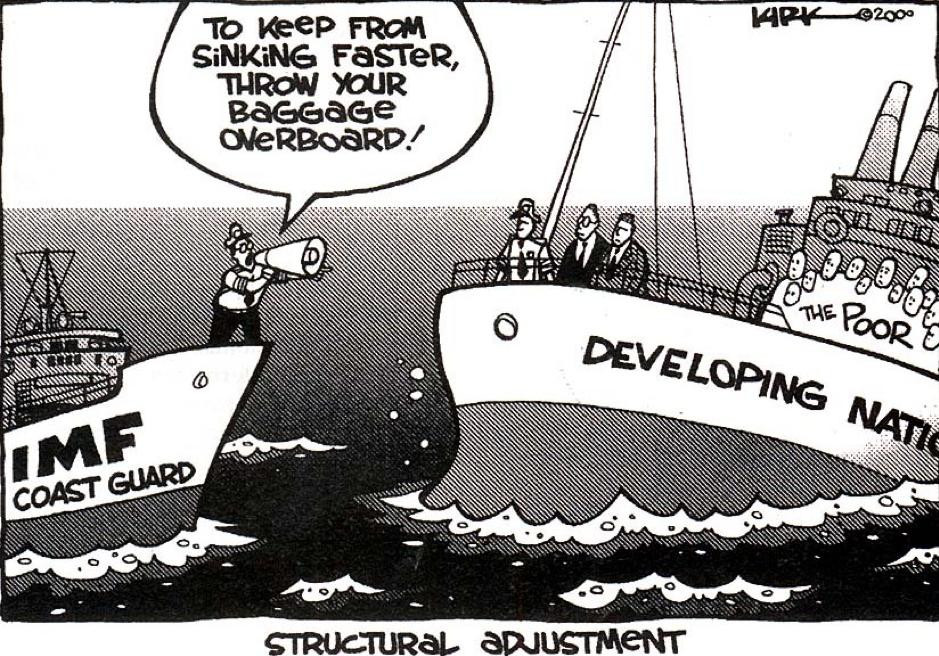
OVERVIEW
MANAGEMENT
PERFORMANCE
POSSIBILITIES
CAPITALS
ACTIVITIES
ACTORS
BURGESS
|
INTERNATIONAL DEVELOPMENT POLICY
THE WASHINGTON CONSENSUS Definition from the Encyclopaedia Britannica 
Original article: https://www.britannica.com/topic/Washington-consensus Peter Burgess COMMENTARY I did my first consulting assignment with the World Bank in 1978, and continued doing assignments for them periodically over the next two decades. When I started this work, there were a significant number of experienced 'development experts' working with the World Bank who had long experience with practical development work around the world ... former colonial officers in the era before independence. Over the next two decades this experience was replaced by a new generation of academically trained development experts many of whom had considerable disdain for the client population. I understand that my own 'personnel file' at the World Bank was not very complimentary about my views on development ... which comes as little surprise since my primary goal has always been to get the best possible results from the expenditure of money and use of other resouces. Peter Burgess | ||
|
Washington Consensus
By Stephen R. Hurt ... The Editors of Encyclopaedia Britannica Washington Consensus, a set of economic policy recommendations for developing countries, and Latin America in particular, that became popular during the 1980s. The term Washington Consensus usually refers to the level of agreement between the International Monetary Fund (IMF), World Bank, and U.S. Department of the Treasury on those policy recommendations. All shared the view, typically labelled neoliberal, that the operation of the free market and the reduction of state involvement were crucial to development in the global South. With the onset of a debt crisis in the developing world during the early 1980s, the major Western powers, and the United States in particular, decided that both the World Bank and the IMF should play a significant role in the management of that debt and in global development policy more broadly. When the British economist John Williamson, who later worked for the World Bank, first used the term Washington Consensus in 1989, he claimed that he was actually referring to a list of reforms that he felt key players in Washington could all agree were needed in Latin America. However, much to his dismay, the term later became widely used in a pejorative way to describe the increasing harmonization of the policies recommended by those institutions. It often refers to a dogmatic belief that developing countries should adopt market-led development strategies that will result in economic growth that will “trickle down” to the benefit of all. The World Bank and IMF were able to promote that view throughout the developing world by attaching policy conditions, known as stabilization and structural adjustment programs, to the loans they made. In very broad terms, the Washington Consensus reflected the set of policies that became their standard package of advice attached to loans. The first element was a set of policies designed to create economic stability by controlling inflation and reducing government budget deficits. Many developing countries, especially in Latin America, had suffered hyperinflation during the 1980s. Therefore, a monetarist approach was recommended, whereby government spending would be reduced and interest rates would be raised to reduce the money supply. The second stage was the reform of trade and exchange-rate policies so the country could be integrated into the global economy. That involved the lifting of state restrictions on imports and exports and often included the devaluation of the currency. The final stage was to allow market forces to operate freely by removing subsidies and state controls and engaging in a program of privatization. By the late 1990s it was becoming clear that the results of the Washington Consensus were far from optimal. Increasing criticism led to a change in approach that shifted the focus away from a view of development as simply economic growth and toward poverty reduction and the need for participation by both developing-country governments and civil society. That change of direction came to be known as the post-Washington Consensus. Stephen R. Hurt ... The Editors of Encyclopaedia Britannica Related Topics: economic planning / liberalization / deregulation
| The text being discussed is available at | https://www.britannica.com/topic/Washington-consensus and |